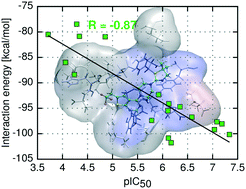当前位置:
X-MOL 学术
›
RSC Med. Chem.
›
论文详情
Our official English website, www.x-mol.net, welcomes your feedback! (Note: you will need to create a separate account there.)
Theoretical models of inhibitory activity for inhibitors of protein–protein interactions: targeting menin–mixed lineage leukemia with small molecules†
RSC Medicinal Chemistry ( IF 4.1 ) Pub Date : 2017-09-12 00:00:00 , DOI: 10.1039/c7md00170c Wiktoria Jedwabny 1, 2, 3, 4 , Szymon Kłossowski 5, 6, 7, 8 , Trupta Purohit 5, 6, 7, 8 , Tomasz Cierpicki 5, 6, 7, 8 , Jolanta Grembecka 5, 6, 7, 8 , Edyta Dyguda-Kazimierowicz 1, 2, 3, 4
RSC Medicinal Chemistry ( IF 4.1 ) Pub Date : 2017-09-12 00:00:00 , DOI: 10.1039/c7md00170c Wiktoria Jedwabny 1, 2, 3, 4 , Szymon Kłossowski 5, 6, 7, 8 , Trupta Purohit 5, 6, 7, 8 , Tomasz Cierpicki 5, 6, 7, 8 , Jolanta Grembecka 5, 6, 7, 8 , Edyta Dyguda-Kazimierowicz 1, 2, 3, 4
Affiliation

|
Development and binding affinity predictions of inhibitors targeting protein–protein interactions (PPI) still represent a major challenge in drug discovery efforts. This work reports application of a predictive non-empirical model of inhibitory activity for PPI inhibitors, exemplified here for small molecules targeting the menin–mixed lineage leukemia (MLL) interaction. Systematic ab initio analysis of menin–inhibitor complexes was performed, revealing the physical nature of these interactions. Notably, the non-empirical protein–ligand interaction energy comprising electrostatic multipole and approximate dispersion terms (E(10)El,MTP + EDas) produced a remarkable correlation with experimentally measured inhibitory activities and enabled accurate activity prediction for new menin–MLL inhibitors. Importantly, this relatively simple and computationally affordable non-empirical interaction energy model outperformed binding affinity predictions derived from commonly used empirical scoring functions. This study demonstrates high relevance of the non-empirical model we developed for binding affinity prediction of inhibitors targeting protein–protein interactions that are difficult to predict using empirical scoring functions.
中文翻译:

蛋白质-蛋白质相互作用抑制剂的抑制活性理论模型:针对小分子脑膜混合血统白血病†
针对蛋白质-蛋白质相互作用(PPI)的抑制剂的开发和结合亲和力预测仍然是药物开发工作中的主要挑战。这项工作报告了PPI抑制剂抑制活性的预测性非经验模型的应用,此处以针对脑膜混合血红蛋白白血病(MLL)相互作用的小分子为例。对menin-抑制剂复合物进行了系统的从头算分析,揭示了这些相互作用的物理性质。值得注意的是,非经验性蛋白质-配体相互作用能包括静电多极和近似色散项(E (10)El,MTP + E Das)与实验测得的抑制活性显着相关,并能准确预测新的menin–MLL抑制剂的活性。重要的是,这种相对简单且计算上可承受的非经验相互作用能模型优于从常用经验得分函数得出的结合亲和力预测。这项研究表明,我们开发的非经验模型与针对蛋白相互作用的抑制剂的结合亲和力预测具有高度相关性,而这些蛋白很难通过经验评分功能进行预测。
更新日期:2017-09-12
中文翻译:

蛋白质-蛋白质相互作用抑制剂的抑制活性理论模型:针对小分子脑膜混合血统白血病†
针对蛋白质-蛋白质相互作用(PPI)的抑制剂的开发和结合亲和力预测仍然是药物开发工作中的主要挑战。这项工作报告了PPI抑制剂抑制活性的预测性非经验模型的应用,此处以针对脑膜混合血红蛋白白血病(MLL)相互作用的小分子为例。对menin-抑制剂复合物进行了系统的从头算分析,揭示了这些相互作用的物理性质。值得注意的是,非经验性蛋白质-配体相互作用能包括静电多极和近似色散项(E (10)El,MTP + E Das)与实验测得的抑制活性显着相关,并能准确预测新的menin–MLL抑制剂的活性。重要的是,这种相对简单且计算上可承受的非经验相互作用能模型优于从常用经验得分函数得出的结合亲和力预测。这项研究表明,我们开发的非经验模型与针对蛋白相互作用的抑制剂的结合亲和力预测具有高度相关性,而这些蛋白很难通过经验评分功能进行预测。



























 京公网安备 11010802027423号
京公网安备 11010802027423号